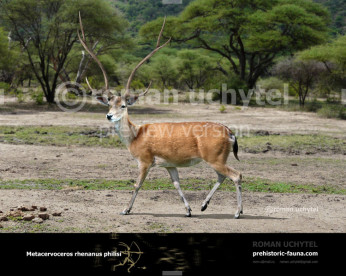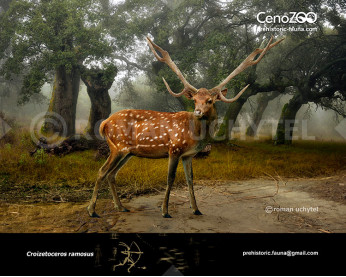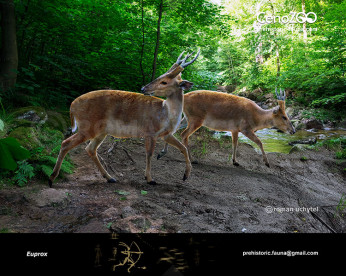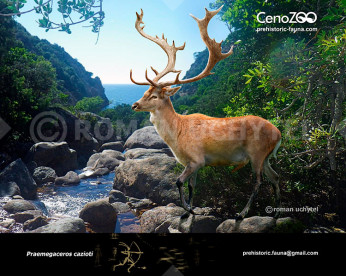Cretan dwarf deer
2024120241Cretan dwarf deer (†Candiacervus (Kuss, 1975))
Order: Artiodactyla
Family: Cervidae
Temporal range: Endemic to Crete from the late Middle - Late Pleistocene
Dimensions: length - 1 m, height - 40 сm, weight - 28 kg.
Candiacervus is an extinct genus Cretan deer is represented by no less than eight different morphotypes, ranging from dwarf size with withers height of about 40 centimetres to very large with withers height of about 165 centimetres, spanning a body mass range from 27.8 kilograms in the smallest species C. ropalophorus to 245.4 kilograms in the largest species C. major. This is explained as an adaptive radiation following ecological release to occupy available niches. The larger species had proportionally longer legs than mainland deer, while the dwarf species had proportionally shorter legs. The short legs of the dwarf species is suggested to be an adaptation to a goat-like niche of climbing around on rocky terrain and consuming low quality foliage. The dwarf species like C. ropalophorus, the antler was simplified and greatly elongated into a club like structure unique among deer. The club-like antlers were probably only used for display rather than combat.
The typical terrestrial mammalian fauna elements of Cretan biozone aside from Candiacervus are a lineage of mice, a dwarf elephant (Palaeoloxodon creutzburgi), the Cretan otter (Lutrogale (Isolalutra) cretensis), and the Cretan shrew (Crocidura zimmermanni).
Despite living in an environment free of large terrestrial predators, the species of Candiacervus exhibited relatively high rates of juvenile mortality, with likely causes of death being accidents and malnutrition. Adult individuals are suggested to have had relatively long lifespans compared to extant ruminants.
The extinction of Candiacervus may be due to the arrival of humans at the end of the Pleistocene. They could have exterminated the deer either actively by hunting, or passively by destroying its habitat. Another option is a gradual depletion of the ecosystem, as indicated by the finding of a complete herd consisting of individuals suffering a bone disease of an osteosclerotic nature.
Cretan dwarf deer (†Candiacervus (Kuss, 1975))
Order: Artiodactyla
Family: Cervidae
Temporal range: Endemic to Crete from the late Middle - Late Pleistocene
Dimensions: length - 1 m, height - 40 сm, weight - 28 kg.
Candiacervus is an extinct genus Cretan deer is represented by no less than eight different morphotypes, ranging from dwarf size with withers height of about 40 centimetres to very large with withers height of about 165 centimetres, spanning a body mass range from 27.8 kilograms in the smallest species C. ropalophorus to 245.4 kilograms in the largest species C. major. This is explained as an adaptive radiation following ecological release to occupy available niches. The larger species had proportionally longer legs than mainland deer, while the dwarf species had proportionally shorter legs. The short legs of the dwarf species is suggested to be an adaptation to a goat-like niche of climbing around on rocky terrain and consuming low quality foliage. The dwarf species like C. ropalophorus, the antler was simplified and greatly elongated into a club like structure unique among deer. The club-like antlers were probably only used for display rather than combat.
The typical terrestrial mammalian fauna elements of Cretan biozone aside from Candiacervus are a lineage of mice, a dwarf elephant (Palaeoloxodon creutzburgi), the Cretan otter (Lutrogale (Isolalutra) cretensis), and the Cretan shrew (Crocidura zimmermanni).
Despite living in an environment free of large terrestrial predators, the species of Candiacervus exhibited relatively high rates of juvenile mortality, with likely causes of death being accidents and malnutrition. Adult individuals are suggested to have had relatively long lifespans compared to extant ruminants.
The extinction of Candiacervus may be due to the arrival of humans at the end of the Pleistocene. They could have exterminated the deer either actively by hunting, or passively by destroying its habitat. Another option is a gradual depletion of the ecosystem, as indicated by the finding of a complete herd consisting of individuals suffering a bone disease of an osteosclerotic nature.

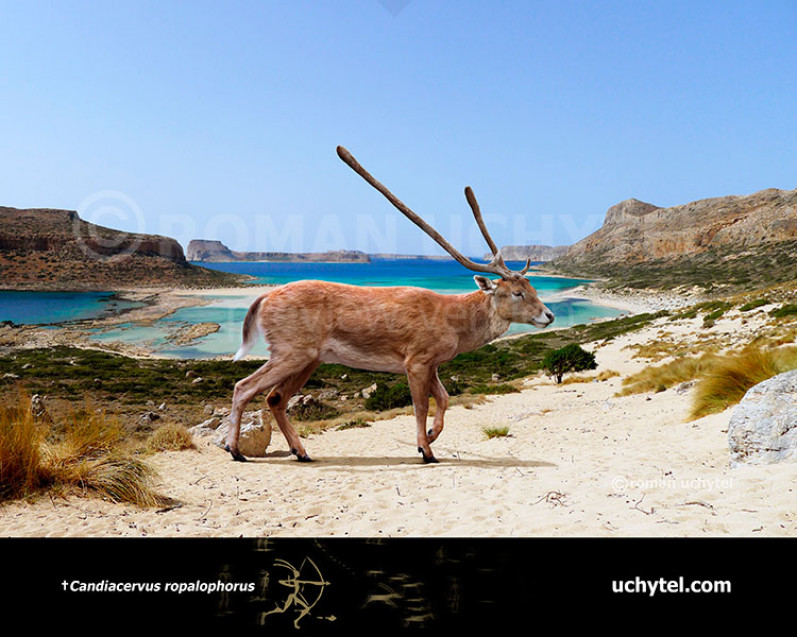
-797x638.jpg)

-70x56.jpg)
